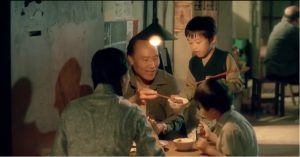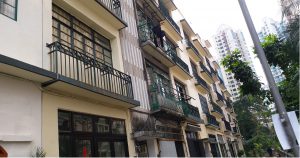ECHOES OF THE RAINBOW, DIR. ALEX LAW KAI YUI (1977)
Wing Lee Street, Sheung Wan, Hong Kong

The residents of Wing Lee Street occupy the public street during mealtime. Scene from Echoes of the Rainbow 2010, directed by Alex Law Kai Yui
Funded by the Hong Kong Government’s Film Development Fund and distributed by Mei Ah Entertainment, Echoes of the Rainbowwas released in February 2010 at the Berlin Film Festival (and publicly released March 2010)1. Mainly told through the lens of eight year-old protagonist Law Chun Yi (nicknamed Big Ears), the film tells the story of the Law family and his childhood journey living in Wing Lee Street. Based partly on director Alex Law Kai Yui’s childhood living in 1960’s Hong Kong, the film recreates Wing Lee Street as a place of community, where the private and public are intertwined.
The film opens with Big Ears running through Wing Lee Street to the Law family’s shoe shop-house, where members of the Law family and the street’s community are introduced. The street’s residents routinely set up tables during mealtime at the public street, claiming it as a communal space, effectively extending the barriers of the house- the street, and in extension Hong Kong, is part of their home as well. Although not entirely pertaining to the apartment plot troupe, the film fulfils similar aspects mentioned by Pamela Robertson Wojcik2, especially that of the porousness of sound. Emphasised by the balconies that line Wing Lee Street, its residents are able to conveniently hear, even see the lives of their neighbours, as shown when Mr. Law 3 berates Desmond 4 for his declining grades. In this sense, Wing Lee Street is not just presented as historical context through its row of tenement buildings (a.k.a. tong lau) that define the house of most in 1960’s Hong Kong, but by narrating Wing Lee Street as the phenomenon of encounters between its residents, the street becomes a symbol of the old Hong Kong housing architecture and community that seems to disappear as they are gradually replaced by high-rise apartments and public housing systems. Although the street’s tong lau are preserved 5, the quietness of the street/buildings, and the uniformity of the renovated exterior (unlike the film where each tenant customises their flat’s exterior) serves as a constant reminder that Wing Lee Street is now a historical site, rather than the community where residents partake on each other’s lives.
Heavily nostalgic in nature, the film’s narrative reverberates with the notion of collective memory and community within the apartment-scape of old Hong Kong. Like all memories, the narrative is filtered by Big Ears’ playfulness and naivety, casting a set of rose tinted glasses onto the poverty and corruption that underlies the social milieu of colonial Hong Kong, a main source of the Law household’s problems. Almost a microcosm of 1960’s Hong Kong, Wing Lee Street acts as a adhesive between the community within and a canvas for memories to form.
— Chung, Wing Sze Cecilia (3035742487)


Left: A neighbour shares his food with Big Ears. Scene from Echoes of the Rainbow 2010, directed by Alex Law Kai Yui
Right: An empty Wing Lee Street during lunch, circa 2021. Photo taken by Cecilia Chung Wing Sze


Left: A neighbour spies on the scene below. Scene from Echoes of the Rainbow 2010, directed by Alex Law Kai Yui
Right: Wing Lee Street’s renovated facade. Photo taken by Cecilia Chung Wing Sze
Notes:
1 Li, Zoe. “Hong Kong Crystal Bear at Berlin Film Festival: ‘Echoes of the Rainbow’ Location to Be Demolished.” Hong Kong Crystal Bear Berlin Film Festival: ‘Echoes of the Rainbow’ location to be demolished, February 24, 2010. https://web.archive.org/web/20100224221317/http://www.cnngo.com/hong-kong/play/hong-kong-film-echoes-rainbow-wins-crystal-bear-berlin-film-festival-739436#ixzz0gH7DfDHI.
2 Wojcik, Pamela Robertson. “What Makes the Apartment Complex?” Essay. In The Apartment Complex: Urban Living and Global Screen Cultures, 1–20. Durham: Duke University Press, 2018.
3 Father of Big Ears, played by Simon Yam Tat Wah
4 Elder Brother of Big Ears, played by Aarif Lee Zhi Ting
5 “Heritage Preservation & Revitalisation- Wing Lee Street.” URA. Urban Renewal Authority. Accessed March 8, 2021. https://www.ura.org.hk/en/project/heritage-preservation-and-revitalisation/wls.
Appreciate your observation on how Wing Lee Street became an extension of the houses and perform as a communal space that might resemble a living room as well. To add more depth to your writing, you could also dive deeper into investigating the reasons behind the uniformity of the renovated exterior of the building. Might it be triggered by changes in building codes and regulations? Which elements would you think could trigger a similar effect on the film in real life? You also mentioned how Wing Lee Street is just like 1960’s Hong Kong condensed in a space. An elaboration on this one would also be worthwhile. For example, you can expand on how exactly was Wing Lee Street was utilised to narrate the encounters and become a symbol to old Hong Kong housing architecture and communities. Then dive even deeper into the spatial characters that represent your claim.